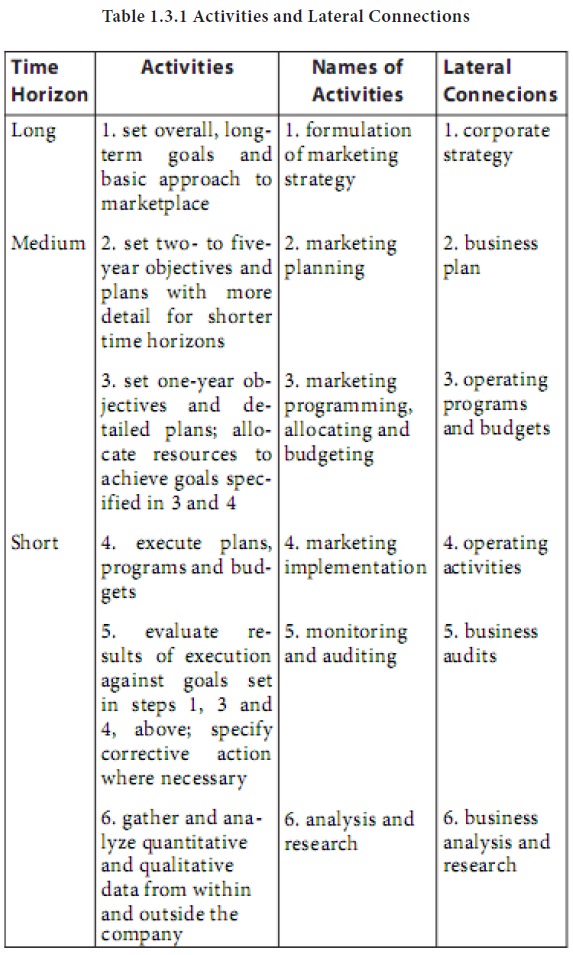MARKETING MANAGEMENT - Marketing Process
Analysis and Research - Marketing Process
Posted On :
All marketing decisions should be based upon knowledge and careful analysis.
Analysis and Research
All marketing decisions should be based upon knowledge and careful analysis. Knowledge can be sourced either from intelligence or from research. While formal analysis and research are important, nothing replaces common sense and good judgment. It implies that managers should develop intelligence- a knowledge base- by observing the developments in the environment. When intelligence is inadequate formal research becomes necessary. The analysis and research need not be quantitative, but it should be deliberate and should be matched to the magnitude of the decision being made.
The marketer’s kit has some very powerful analytical tools and the rapid development of decision support systems, mathematics including statistics, and other supporting disciplines such as psychology and sociology insure that the diversity and power of the tools will continue to increase. All of the tools must be applied carefully and intelligently to the decision at hand. It is a fine line, indeed between healthy skepticism and arrogant neglect of useful tools. The right analytical tool well applied can substantially improve marketing decision making.
Table 1.3.1 has two dimensions. The first is temporal – it shows the natural development from strategy formulation through planning, programming, allocating and budgeting on to implementation. This process is not nearly as ‘clean and separated’ as the table implies. The activities are interrelated and contemporaneous.
The second dimension is the lateral connection to other functional parts of the organization, such as production and operations, finance, control and human resources management. Each step has a company or business counterpart in the right-hand column. The marketing strategy thus becomes part of the total corporate strategy, which includes all functional areas.
The marketing plan is often part of a broader corporate business plan. The marketing plan is usually the ‘front end’ of the corporate plan, because it spells out the operation, human and financial resources needed to support the organization’s approach to its markets.

Marketing programs and budgets are usually part of the organization’s fundamental operating documents. For example, the sales forecasts in the programs and budgets become the production schedule for the manufacturing function. Those, in turn, become the staffing programs for the human resource function and indicate the working capital needs to be supported by the financial function. If finance cannot support such a high level of inventory and accounts receivable, the sales forecast, production schedule and staffing program must be scaled down. In most organizations, great effort must be devoted to such lateral connections. The coordination needs are very high and the amount of conflict often great. Risk aversion and opportunity sensitivity differ among functions. Varying reward systems sometimes encourage different types of behaviour. The organization must develop formal and informal ways to foster good, open lateral connections.
All marketing decisions should be based upon knowledge and careful analysis. Knowledge can be sourced either from intelligence or from research. While formal analysis and research are important, nothing replaces common sense and good judgment. It implies that managers should develop intelligence- a knowledge base- by observing the developments in the environment. When intelligence is inadequate formal research becomes necessary. The analysis and research need not be quantitative, but it should be deliberate and should be matched to the magnitude of the decision being made.
The marketer’s kit has some very powerful analytical tools and the rapid development of decision support systems, mathematics including statistics, and other supporting disciplines such as psychology and sociology insure that the diversity and power of the tools will continue to increase. All of the tools must be applied carefully and intelligently to the decision at hand. It is a fine line, indeed between healthy skepticism and arrogant neglect of useful tools. The right analytical tool well applied can substantially improve marketing decision making.
Table 1.3.1 has two dimensions. The first is temporal – it shows the natural development from strategy formulation through planning, programming, allocating and budgeting on to implementation. This process is not nearly as ‘clean and separated’ as the table implies. The activities are interrelated and contemporaneous.
The second dimension is the lateral connection to other functional parts of the organization, such as production and operations, finance, control and human resources management. Each step has a company or business counterpart in the right-hand column. The marketing strategy thus becomes part of the total corporate strategy, which includes all functional areas.
The marketing plan is often part of a broader corporate business plan. The marketing plan is usually the ‘front end’ of the corporate plan, because it spells out the operation, human and financial resources needed to support the organization’s approach to its markets.

Marketing programs and budgets are usually part of the organization’s fundamental operating documents. For example, the sales forecasts in the programs and budgets become the production schedule for the manufacturing function. Those, in turn, become the staffing programs for the human resource function and indicate the working capital needs to be supported by the financial function. If finance cannot support such a high level of inventory and accounts receivable, the sales forecast, production schedule and staffing program must be scaled down. In most organizations, great effort must be devoted to such lateral connections. The coordination needs are very high and the amount of conflict often great. Risk aversion and opportunity sensitivity differ among functions. Varying reward systems sometimes encourage different types of behaviour. The organization must develop formal and informal ways to foster good, open lateral connections.
Tags : MARKETING MANAGEMENT - Marketing Process
Last 30 days 416 views












